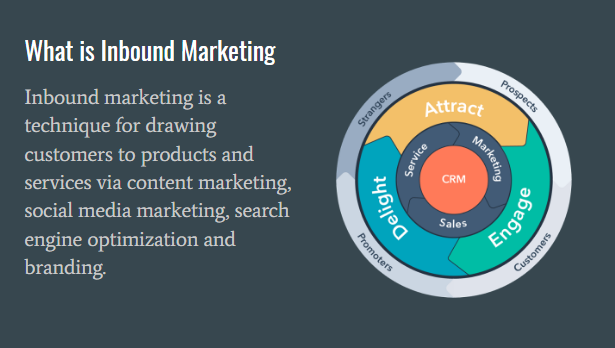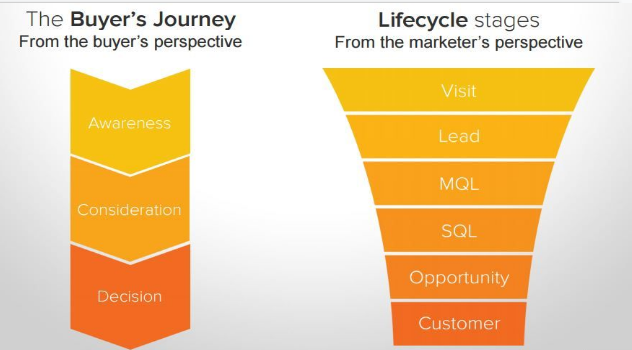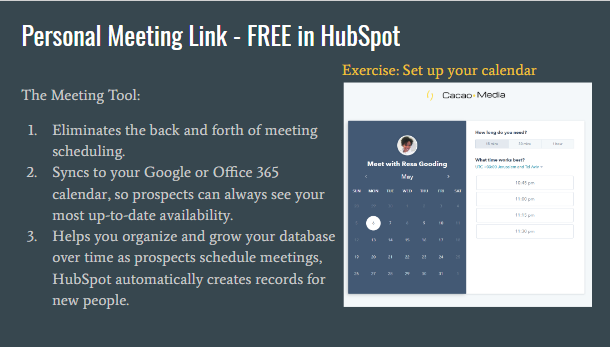Last Sunday, Resa and the team at Cacao Media, hosted their 5th Hubspot workshop this year. Every event focuses on a different topic and one thing is for sure, as each one progresses, the room gets more crowded and diverse (Hi iCan).
This meetup was a tactical one, focusing on Workflows and Sequences. Although some of the information is probably familiar to those who are already using HubSpot’s Marketing Automation capabilities, there are always nuggets to be discovered that make the day-to-day more efficient.
Inbound Marketing and Marketing Automation
As many of you know, CRM stands for “Customer Relationship Management” emphasis on the word “Relationship.” By using Inbound Marketing, Marketers can develop and nurture a connection with their audience via multiple channels (content marketing, social media marketing, search engine optimization, and branding) and measure the results. Marketing Automation allows us to automate repetitive tasks that are associated with this process.

The Buyer's Journey
The journey to purchasing is different from a customer’s perspective than it is from a marketer’s perspective. The customer becomes aware of a product, does research and then makes a purchasing decision. A Marketer, on the other hand, needs to look at the cycle differently so they can create touchpoints and content that will provide information and value to the potential customer.

Different technologies support each part of the cycle to give the Marketer an overview of each stage and provide insight into what is working and what may need tweaks and optimization. The goal of this nurturing is to lead a visitor through the funnel and promote them in different stages where they can either progress from a Marketing Qualified Lead (MQL) to a Sales Qualified Lead (SQL) or can be leveraged for other roles like a reference or influencer.
Hubspot Components
HubSpot provides suites of tools for Marketing, Sales, and Service, and they all revolve around one thing, customers (or contacts in your database).
It is essential to understand the components that make up Hubspot because they are the foundation of your data. The primary building block of that foundation is your contacts. They are the people in your database and the heart of your activity. As in every workshop, Resa stressed the importance of keeping your contacts database in pristine condition and suggests that once a quarter you take time and audit your contacts.
Resa also outlined the key components of the Marketing Hub to see which tools support which parts of the Marketing Automation process
Prospects - A must-use tool for Marketing and Sales
HubSpot offers a great tool called Prospects which allows Marketing and Sales to see which IP addresses have visited a website (provided you have connected your website to HubSpot). While you cannot see individual people, you can see which companies visited the site along with how pages they visited. This information is handy in ABM and retargeting and other strategic approaches. Check out Meghan Hultquist's 11 Clever Ways to Use HubSpot's Prospects Tool.
Tips for cold outreach in Sales
Many times a cold outreach does not hit its mark because the communication is lacking personalization and value, and does not reference what is in it for the person receiving side.
Here are some tips that can make prospecting much more productive:
- Put Yourself in Their Shoes - picture them receiving an email from a competitor right before yours. How will you stand out?
- Write Like You Talk - try to read your email out loud before you send it, to see how it sounds. If it seems strange, make some tweaks. (if you don't speak the native language, ask someone who does to review your email)
- Forget the introduction! - Don’t dedicate any of your message to introducing yourself or your company. They don’t know you, and they don’t care
- Get to the Point - Get right to the point and focus on THEM, not your offer.
- Keep it Short - Keep it two to four sentences and five sentences at the MOST.
- Personalize What You Can - Referencing a company name is decent, but even just referencing their industry will typically be enough if you’re providing something of value.
- Put All Contact Info in Your Signature
- Include a P.S. and a P.P.S - Like this: P.S. If you aren’t the right person to contact, let me know! Don’t want to receive any more emails? Let me know that, too! P.P.S. Here’s the link to [excellent resource], again. Would love to hear your feedback
- Don’t ask for a meeting in the first email, instead close with a question - The goal is to get them to respond to start a dialogue so ending with questions like “Idea #6 is my favorite, how about you?” prompts the receiver to respond without any commitment
- Follow Up, then Follow Up Again! - 85% of the hot leads usually come AFTER the initial email send. Create a series of follow-up messages that go out to people who don’t respond right away. Every 3 to 7 days you should send another.
- Test Your Messages - Measure three things to determine the success of an email: Open Rate, Response Rate, Sales Generated.
Test your methods and messaging
Subject Line
- Specific versus vague – Test out subject lines that mention what is in the email specifically versus a more general subject line, such as “30-second question for research on accounting” versus “quick question.”
- Personalized vs. localized – Instead of personalizing the subject line with your prospect’s name, why not try using their company’s location instead? “Mike, this offer’s just for you.” vs. “New York SEO services.”
- Your company vs. their company – Try subject lines that only consist of the name of your company or the name of their company. Super simple, both of these subject lines should see good open rates, though your response rate may be low since there is no indication of what the email contains.
- Questions – Ask a question in your subject line, such as, “Do you need SEO?” With this variation, your open rates may drop, but the proportion that responds should go up, since people who opened the email will have already answered your question in the affirmative.
- Oddly specific numbers – Draw your prospect's eye to your email by using random, specific numbers in the subject line, like “Why He Paid Google $5,129,346.21”
- Percentages – Similar to using numbers, using irregular characters in your subject line can help your email stand out in your prospect’s inbox.
Content
- Humorous vs. straight-laced – Injecting a quick joke or unexpected one-liner can help brighten up dull emails. Don’t go overboard, but maybe try using a meme or pop culture reference in your next batch.
- Saying “Thanks” – Test out different versions of “thank you” in your email, like None:no mention of thanks in the email at all; Manipulative: “Thanks in advance for your help.” ; Appreciative: “I imagine you’re super busy, so your response would mean a lot!”
- Short vs. long – It’s been pretty well documented that short emails get higher CTRs, but is there such a thing as too short? Test out variations from 1-2 sentences to 4-5 short paragraphs to find your ideal length.
- Text-based vs. images – Send out versions of your cold emails that are entirely text-based as well as some that use 1 or 2 well-placed, content-specific images.
- Link placement – If your cold email contains links, test out these links, in the beginning, middle, end, or a combination of locations.
Delivery
- Time of day - test out different times of day to send your emails. Right after lunch often gets better response rates
- Day of the week – Depending on your target market, your cold email might be better received on weekends or weekdays.
- Follow Up
- Number – How many times will you follow-up with your prospects? Test this metric to find the optimal number before a prospect either converts or unsubscribes.
- Frequency – Space out your follow-ups at different intervals to find the best converting sequence.
- Style – Depending on your prospects’ reaction to your first email, you can place them into 1 of 3 follow-up styles, and tailor your follow-up emails for each specific group.
- Those who did not open the email – Try the same content with a different subject line.
- Those who opened your email, but didn’t click – Try putting a time constraint on your offer.
- Those who clicked on your emails – Try offering a direct incentive for signing up
Some more must-use tools
Personal Meeting link and Inbox tracking
You can connect your email/calendar account to HubSpot and access to a great tool called Personal Meeting Link. This allows potential prospects to seamlessly book a meeting with you directly on your calendar, without the back and forth of verifying when each side is free. According to one of the workshop participants, this tool has dramatically increased the number of calls scheduled at her company.

You can also connect your inbox to HubSpot and track people who have opened your emails and links they have clicked on.
Templates
Templates allow you to create pre-made emails that you can personalize, without having to type the same content each time.
Additional HubSpot Sales Tools
Sequences & Workflows
Hubspot offers two ways to automate the conversation with your audience - Sequences and WorkFlows
Sequences are geared towards Salespeople to help them automate their outreach. It is a less complex nurturing tool than Workflows and is used for a targeted purpose, period of time, or specific goal, e.g. scheduling a call, signing up for a webinar or meeting at a tradeshow.
Sequences are a great tool to help Salespeople scale their activity and also provides AI based insights on the content and timing so Sales can optimize their outreach.
Workflows is a sophisticated tool that allows you to automate multiple actions. They are triggered based on a person’s behaviors or contact information. Workflows are at the core of elaborate Marketing Automation processes and help create the human and helpful experience that promotes growth.
Starting from the end
When you are defining a workflow, the important thing is to determine the goal you are hoping to achieve and from there build the steps that will guide your audience to reach the desired outcome.
A multitude of options helps you customize workflows to your specific needs and going through all of them would take days. Workflows can, however, tie together the nurturing of potential customers in the Marketing and Sales Funnels to internal processes where people in the organization get notified about a visitor's behavior and can then act accordingly. Here are some resources from HubSpot that give you a more in-depth introduction :
Resources: Understanding WorkFlows in HubSpot (you need to sign up to view); Getting Started with WorkFlows
One of the most vital tips that Resa gave us during the workshop: DO NOT CHANGE A WORKFLOW AFTER YOU HAVE ACTIVATED IT AND IT IS STILL RUNNING - this can screw up many of your processes
If you want to make a change, it is best to turn off the workflow, clone it, turn on the new workflow and delete the old one. Also if you want to keep old workflows for future reference, agree with your team about a naming convention so that everyone knows which workflows are active and which are dormant.
Sequences vs. Workflows: When to use each tool
Sequences are better suited for sales, as it allows the Sales team the ability to customize the timing and the content of the individual steps in the flow and offers a valuable opportunity to make each email specific to your prospect in some way.
Here are some pointers on how to choose which tool is right for what you are trying to achieve as well as an online resource that can also help you better determine whether you should use a workflow or a sequence.
I hope you found this summary helpful. It is just a taste of what Marketing Automation do for your organization. The key to a successful process is remembering that there are people on the receiving end of your activity and they should feel that they are getting value from the connection with you and your company.

 By
By